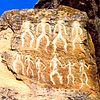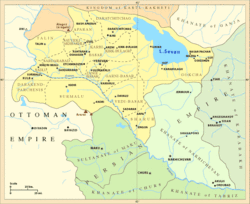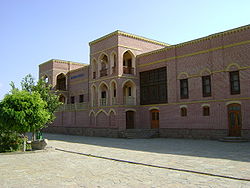- Khanate of Nakhichevan
-
Khanate of Nakhichevan khanate 1747–1828 The Nakhichevan and Yerevan khanates, c.1800. Capital Nakhichevan Political structure khanate History - Established 1747 - Disestablished 1828 Warning: Value specified for "continent" does not comply History of Azerbaijan 
This article is part of a seriesAntiquity Ancient history and Roman era Atropatene First Persian Empire
and Alexander's conquestsCaucasian Albania Middle Ages Islamic period Seljuk dynasty Atabegs of Azerbaijan Ilkhanate Qara Qoyunlu Aq Qoyunlu Shirvanshahs Classical history Safavid dynasty Khanates Qajar dynasty Russian Rule Early independence History of the name Azerbaijan Azerbaijan Democratic Republic March Days Soviet Azerbaijan Azerbaijan SSR Black January Modern Azerbaijan Republic of Azerbaijan
Azerbaijan Portal
The Khanate of Nakhichevan (Azerbaijani: Naxçıvan xanlığı; Persian: خانات نخجوان) was a feudal state[1] in the southern Caucasus, nominally subordinate to the Persian Shahs, and named after its chief settlement, the town of Nakhichevan.
The territory of the khanate corresponded to most of the present-day Nakhchivan Autonomous Republic and central parts of present-day Armenia.[2]
Contents
History
Initially the territory of Nakhichevan was part of Čoḵūr Saʿd, but later came to be ruled by a separate khan.[3] Shortly after the capture of Erevan in 1604, Shah ʿAbbās I appointed Maqsud Sultan[4], a leader of a Turkic[4] tribe named Kangarlu, described by J. M. Jouannin as “a small tribe established in Persian Armenia, on the shores of the Aras"[4] as governor of Nakhichevan.[4] Later that year, Ottoman forces threatened the area, Shah Abbas ordered Maqsud Sultan to evacuate the entire population of the Nakhichevan region (including the Armenians of Jolfa, who, in the following year, were transplanted to Isfahan) to Qaraja Dag (Arasbaran) and Dezmar.[4]. Persian rule was interrupted by Ottoman occupation between 1635-1636 and 1722-1736.
During the Russo-Persian War of 1804-1813, in 1808 Russian forces under general Gudovich briefly occupied Nakhichevan, but as a result of the Treaty of Gulistan it was returned to Persian control.[5]
During the Russo-Persian War of 1826-1828, in 1827 Abbas Mirza appointed Ehsan Khan Kangarlu as commander of Abbasabad, a fortress of strategic importance for the defense of the Nakhichevan khanate.[6] After heavy losses in an attempt to take the fortress by escalade on July 14, the Russians mounted a siege. Ehsan Khan secretly contacted the Russian commander, General Paskevich, and opened the gates of the fortress to him on 22 July 1827. With the Treaty of Turkmenchay, in 1828 the khanate became a Russian possession and Ehsan Khan was rewarded with the governorship,[6] conferred the rank of major-general of the Russian army and the title of campaign ataman of the Kangarlu militia.[7]
The abolition of the khanate
In 1828 the khanates of Erivan and Nakhichivan were dissolved and their territories united to form the Armenian Oblast ("Armianskaia Oblast"). In 1840 that province was dissolved and its territory incorporated into a larger new province, the Georgia-Imeretia Governorate ("Gruziia-Imeretiia"). This new division did not last long – in 1845 a vast new territory called the Caucasian Territory ("Kavkazskii Krai") or Caucasian Viceregency ("Kavkazskoe Namestnichestvo") was created, in which the former Armenian Province formed part of a subdivision named the Tiflis Governorate. In 1849 the Erivan Governorate was established, separate from the Tiflis Governorate. It included the territory of the former Nakhchivan khanate, which became the province's Nakhichevan uyezd.[8]
After the dissolution, the khans of Nakhichevan took the Russified surname Khan Nakhichevanski, and the men of its family traditionally entered the Russian public services, chiefly the army. The family remained very wealthy, were the biggest landowners in the district, and continued to exercise enormous influence over the rest of the Moslem community.[9] Six Khans Nakhchivanski became generals in the Russian tsarist, Soviet and Iranian armies. Two sons of Ehsan khan - Ismail khan and Kalbali khan - were generals in the Russian army and were awarded orders of Saint-George IV degree for their actions in battle. A son of Kalbali khan, Huseyn Khan Nakhichevanski, was a prominent Russian military commander and adjutant general of the Russian Emperor, and his nephews, Jamshid Khan and Kalbali, were generals in the Soviet and Iranian armies respectively.[10]
Rulers
The rulers where:[11]
- 1747-1787 - Heydargulu Khan
- Haji Khan Kangarli
- Rahim Khan
- Aligulu Khan
- Valigulu Khan
- Abbasgulu Khan
- Jafargulu Khan
- 1787-1823 - Kalbali Khan
- Abbasgulu Khan Kangarli
- Mahammadbagir Khan
- 1823-1828 - Ehsan Khan, Major General in the Russian Imperial Army, previously governor of Ordubad in 1922[12]
- 1828-1834 - Karim Khan Kangarli[13]
Notes
- ^ William Bayne Fisher, Peter Avery, Ilya Gershevitch, Gavin Hambly, Charles Melville. The Cambridge History of Iran: From Nadir Shah to the Islamic Republic. Cambridge University Press, 1991. ISBN 0521200954, 9780521200950
- ^ Hewsen, Robert H. Armenia: a Historical Atlas. Chicago, IL: University of Chicago Press, 2001, map 149.
- ^ Bournoutian, George A. (1992). The Khanate of Erevan Under Qajar Rule, 1795-1828. p. 32.
- ^ a b c d e Oberling, P. "Kangarlu". Encyclopedia Iranica. http://www.iranica.com/newsite/articles/unicode/ot_grp5/ot_kangarlu_20040211.html. Retrieved 2009-02-01.[dead link]
- ^ (Russian) Записки о службе генерал-фельдмаршала графа И. В. Гудовича, составленные им самим
- ^ a b Ekbal, Kamran. "ʿAbbāsābād (2)". Encyclopedia Iranica. http://www.iranica.com/newsite/articles/unicode/sup/Abbasabad.html. Retrieved 2009-02-01.[dead link]
- ^ (Russian) Иванов Р. Н. Именем Союза Советских… Жизнь и гибель комбрига Нахичеванского. — М.: Герои Отечества, 2007.
- ^ Hewsen, Robert H. (2001). Armenia: a Historical Atlas. Chicago, IL: University of Chicago Press. p. 173. ISBN 0226332284.
- ^ Villari, Luigi (1906). Fire and Sword in the Caucasus. London: T. F. Unwin. pp. 266–268. ISBN 0-7007-1624-6.
- ^ (Russian) Иванов Р. Н. (2007). Именем Союза Советских… Жизнь и гибель комбрига Нахичеванского.. Moscow: Герои Отечества. OCLC 351718188.
- ^ Azerbaijani Soviet Encyclopedia, Baku, 1983, vol. 7, p. 176
- ^ George A. Bournoutian (1998). Russia and the Armenians of Transcaucasia, 1797-1889. p. 516. ISBN 1568590687.
- ^ Martijn Theodoor Houtsma, et al., eds., ed. "Nakhcuwan". Encyclopaedia of Islam. Brill Publishers. OCLC 8096647.
See also
Khanates of the Caucasus Baku Khanate · Erivan Khanate · Ganja Khanate · Karabakh khanate · Nakhchivan khanate · Quba Khanate · Shaki Khanate · Shirvan Khanate · Talysh Khanate · Avar Khanate · Kazi-Kumukh Shamkhalate · Kazi-Kumukh KhanateCategories:- States and territories established in 1747
- States and territories disestablished in 1828
- 1828 disestablishments
- History of Armenia
- Khanates of the South Caucasus
- History of Azerbaijan
- Nakhchivan
Wikimedia Foundation. 2010.


